Illustration of the detailed steps of Espresso coffee extraction how to do Italian concentration
Now many coffee students and coffee makers in domestic coffee shops believe that the key technology of Italian coffee production is the production of milk foam and coffee flower. But the most important thing about Italian coffee is Espresso extraction.
The main reason for this difference is that in Italian coffee shops abroad, more than 70% of coffee sales are Espresso (mainly in Italy) and black coffee (that is, American coffee in Seattle-style coffee shops, mainly in the United States, Japan and South Korea). However, the main varieties sold in many domestic coffee shops are milk coffee such as Latte or Mocha. Milk can cover most of the taste of Espresso, which, of course, covers the defects of Espresso. Two cups of Latte made by Espresso with completely different taste may taste exactly the same. But black coffee is only Espresso with water, and the water itself has no taste, so any taste difference will be fully reflected on the tongue.
Miss Li of ILLY Coffee University in Italy also introduced that the main content of ILLY's international certification exam for baristas is also Espresso extraction, and the ILLY exam does not include coffee flowers.
The following "my friend eats and drinks" uses a group of pictures to briefly illustrate some problems that need to be paid attention to when extracting Espresso:

Work begins: first remove the brewing handle from the coffee maker. (need to pay attention to two things: first, always buckle the hand on the brewing head to keep warm, do not put it on the warm cup or plate or other places, otherwise the low temperature handle when brewing coffee will lower the temperature of the brewing water and cause the coffee to go sour. Second, the coffee grounds inside should not be deducted before brewing the next cup of coffee, because the copper cooking head at high temperature will produce a peculiar smell, and the coffee grounds can absorb the smell.)
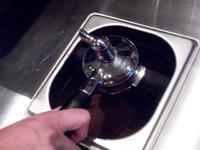
Deduct the coffee grounds. A handle that has not been used for a long time will cause the coffee grounds to stick to the bottom of the coffee filter and can be brushed off with a plastic brush.)
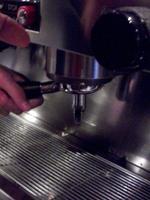
Buckle the hand to the brewing head, press the brewing key to wash the handle and the brewing head, and shake the handle constantly in order to rinse the coffee residue glued to the brewing head. (note: if you load the powder directly without rinsing the head, the residue glued to the head will be extracted again, causing the coffee to become bitter and astringent. In addition, this is also equivalent to releasing water in the front section to prevent the boiling water from being too hot, resulting in excessive extraction.)

The coffee residue in the hand will be poured out. (the action of flushing the head can be repeated to ensure that the head will be washed clean.)

Wipe the filter in your hand completely with a dry towel. It is absolutely necessary to keep dry in the filter. If there is water in the filter, the coffee powder will start the coffee extraction process before brewing, resulting in excessive extraction. In addition, it will also make the coffee powder agglomerate, resulting in uneven filling pressure. Also, dry the outlet of your hand to prevent the coffee powder from flowing into the cup.)
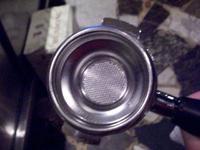
Dry filter
You can load the powder now. (it should be noted that there is no powder left in the dispenser. Each time it is boiled and ground, the coffee powder will oxidize completely after being exposed to the air for a few minutes, and the brewed coffee will not be able to drink. Now some coffee shops are used to filling up their dispensers, which is not correct. The right thing to do is to quickly pull the dispenser lever while grinding the powder, turn it off when the handle is almost full, and continue to pull the dispenser lever until all the coffee powder in the meter falls into the brewing handle.)
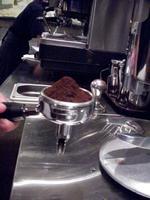
A powdered handle. The powder in the handle should be piled into a hill so that the inside of the handle will be completely filled when powdered.)
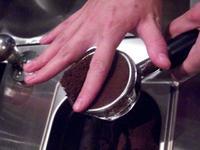
Smooth the powder in the handle with your hand or scraper. (two precautions: first, wipe the powder back and forth when applying powder to make sure that the coffee powder fills all the gaps in the handle. If you use your hands, remember to wash your hands first. Second, the excess powder should be put into the dregs bucket, do not wipe back the quantifier, otherwise the coffee powder scalded by the high temperature will affect the taste of the next cup of coffee.)

The handle after powdering.
Pressing powder for the first time. Some netizens usually use the secondary filling method, the force of the first filling should not be too great, just press the coffee powder into the filter, generally within the 5kg.)
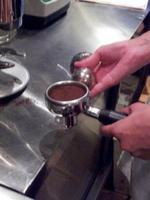
Tap the handle once laterally to make the coffee powder on the edge of the filter fall into the filter. (note: do not overpower, generally also in the 5kg, otherwise it is easy to concentrate coffee powder on the other side of the filter. In addition, you can only knock once. Xu has seen a lot of people knock many times, which is incorrect, because repeated tapping on the outside of the handle will concentrate the coffee powder to the middle of the filter, creating an edge gap and making the coffee extraction unbalanced.)
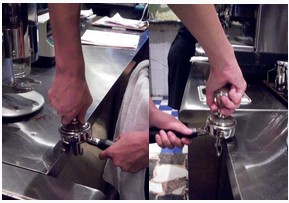
(the picture on the left is the correct position of powder pressing, while the picture on the right is incorrect. If you have the problem of uneven powder pressing, it is probably because the forearm is not kept vertical during powder pressing.)
Secondary pressing powder. (the second pressing powder should pay attention to: first, the pressing power should be controlled within 10-20kg, and the strength mainly depends on the grinding thickness of coffee powder. Second, keep the forearm vertical when pressing the powder, otherwise the coffee powder will be high on one side and low on the other in the filter, resulting in unbalanced extraction. This is difficult and requires a lot of practice. some people have to practice thousands of times to make sure that most of the packing is flat.)
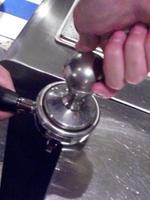
After the powder pressing is completed, rotate the powder press more than 360 degrees, the purpose is to make the coffee powder surface smooth, better resistance to cooking water pressure to ensure normal extraction.
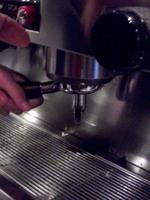
Buckle the hand to the head. (note: press the brewing button immediately after buckling, and then get the coffee cup. In addition, the whole powder filling process should be rapid, because the coffee powder in the high temperature handle for too long will burn the coffee, causing the coffee to become bitter.)
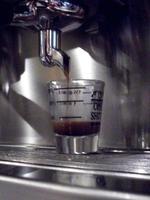
Coffee extract. The normal extraction time is 18 to 25 seconds to extract 20 to 30ml coffee, this is a personal point of view. This coffee should flow out like a paste and should not be spurted. If the flow rate is too fast, it is likely to be too coarse or too light to fill. It can not be a drop by drop, in that case it may be too fine grinding or too strong filling pressure. There is also the same person made of Espresso in the same grinding thickness, the same amount of extraction, the extraction time difference can not be more than 1 second, otherwise the filling pressure is unstable or uneven, the coffee taste difference will be very obvious, we need to continue to practice.)

After the completion of the Espresso (after the completion of the coffee handle, coffee pressed powder surface smooth should not have any depression, otherwise the filling pressure is incorrect, need to continue to practice.)
After using the finished Espresso to add water to make black coffee (American coffee), if there is no miscellaneous taste, no astringent taste, no water in the coffee, and the bitterness of the coffee disappears quickly after the coffee is imported, it shows that the extraction of Espresso is basically qualified. In addition, the continuous production of 5 to 10 cups (the same specification coffee handle), coffee extraction time and coffee taste can not be significantly different. It shows that the technology is basically stable.
Important Notice :
前街咖啡 FrontStreet Coffee has moved to new addredd:
FrontStreet Coffee Address: 315,Donghua East Road,GuangZhou
Tel:020 38364473
- Prev
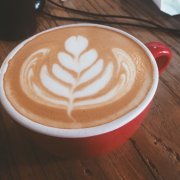
Talking about the principle of espresso extraction is it good to analyze the espresso of tiger spot?
Today, with the vigorous development of Italian milk coffee, the taste and taste of espresso also highlight its status. Espresso is the cornerstone of a cup of coffee, its quality and taste are directly related to the quality of a cup of coffee! In the international WBC barista competition, the production of espresso is also an important competition point. Coffee industry insiders and coffee lovers all over the world have set their sights on this only 3.
- Next

How to extract a perfect espresso espresso with tiger spots
Each cup of espresso has a layer of brown fine oil on the surface, which is called crema. If you look closely, you will find that the crema color on the surface of each espresso is different, and the common crema colors range from light gold, hazelnut, ochre to dark brown. What message does these crema with different colors reveal to us? Things
Related
- Beginners will see the "Coffee pull flower" guide!
- What is the difference between ice blog purified milk and ordinary milk coffee?
- Why is the Philippines the largest producer of crops in Liberia?
- For coffee extraction, should the fine powder be retained?
- How does extracted espresso fill pressed powder? How much strength does it take to press the powder?
- How to make jasmine cold extract coffee? Is the jasmine + latte good?
- Will this little toy really make the coffee taste better? How does Lily Drip affect coffee extraction?
- Will the action of slapping the filter cup also affect coffee extraction?
- What's the difference between powder-to-water ratio and powder-to-liquid ratio?
- What is the Ethiopian local species? What does it have to do with Heirloom native species?

